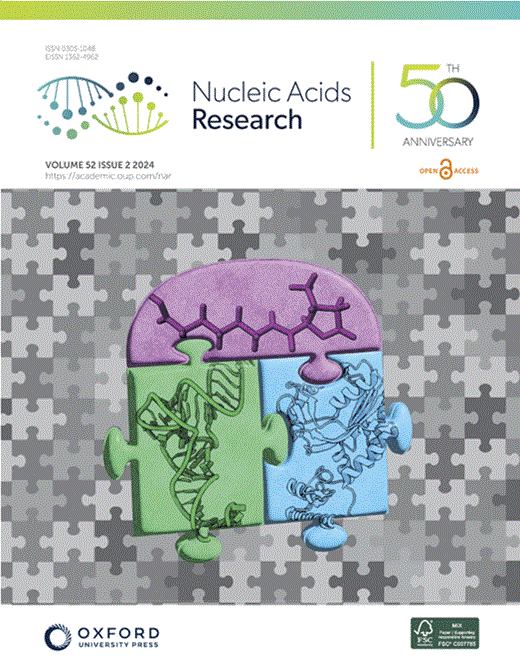Transcription regulation by RNA-induced structural strain in duplex DNA.
IF 16.6
2区 生物学
Q1 BIOCHEMISTRY & MOLECULAR BIOLOGY
引用次数: 0
Abstract
Non-coding RNAs belong to a heterogenous family that, among other functions, acts as a biomolecular regulator of gene expression. In particular, lncRNAs, which are estimated to be as numerous as coding RNAs in humans, are thought to interact with genomic DNA to form triple helices. However, experimental evidence of their involvement with processes, such as chromatin structure dynamics or RNA transcription, is still missing. Here, a mechanism of transcription enhancement/inhibition is described, where hybrid RNA-DNA triplexes regulate transcription rates in Escherichia coli promoter-based designed architectures. Sequences associated with triplexes were identified in a library of bacterial promoters and characterized in vitro, followed by a synthetic biology approach to verify their ability to control transcription and translation. A model of the triplex-promoter complex was produced showing that transcription enhancement is due to a distortion of the duplex DNA as a consequence of its conjugation with RNA in the triplex assembly. These results point at a mechanism of RNA function that is still unknown and could be common in more complex organisms, such as metazoans including mammals, where non-coding RNAs are more abundant and are believed to play a fundamental role in determining hetero/euchromatin and transcription modulation.rna诱导的双链DNA结构应变的转录调控。
非编码rna属于异质家族,在其他功能中,作为基因表达的生物分子调节剂。特别是lncRNAs,据估计其数量与人类编码rna一样多,被认为与基因组DNA相互作用形成三螺旋。然而,它们参与过程的实验证据,如染色质结构动力学或RNA转录,仍然缺失。本文描述了一种转录增强/抑制机制,其中杂交RNA-DNA三联体调节大肠杆菌基于启动子的设计结构中的转录率。在细菌启动子文库中鉴定了与三联体相关的序列,并在体外进行了表征,随后采用合成生物学方法验证了它们控制转录和翻译的能力。三联体启动子复合物的模型显示转录增强是由于双链DNA在三联体组装中与RNA结合导致的扭曲。这些结果表明,RNA的功能机制仍然是未知的,可能在更复杂的生物中是常见的,如包括哺乳动物在内的后生动物,其中非编码RNA更丰富,被认为在决定异染色质/常染色质和转录调节中起着基本作用。
本文章由计算机程序翻译,如有差异,请以英文原文为准。
求助全文
约1分钟内获得全文
求助全文
来源期刊

Nucleic Acids Research
生物-生化与分子生物学
CiteScore
27.10
自引率
4.70%
发文量
1057
审稿时长
2 months
期刊介绍:
Nucleic Acids Research (NAR) is a scientific journal that publishes research on various aspects of nucleic acids and proteins involved in nucleic acid metabolism and interactions. It covers areas such as chemistry and synthetic biology, computational biology, gene regulation, chromatin and epigenetics, genome integrity, repair and replication, genomics, molecular biology, nucleic acid enzymes, RNA, and structural biology. The journal also includes a Survey and Summary section for brief reviews. Additionally, each year, the first issue is dedicated to biological databases, and an issue in July focuses on web-based software resources for the biological community. Nucleic Acids Research is indexed by several services including Abstracts on Hygiene and Communicable Diseases, Animal Breeding Abstracts, Agricultural Engineering Abstracts, Agbiotech News and Information, BIOSIS Previews, CAB Abstracts, and EMBASE.
 求助内容:
求助内容: 应助结果提醒方式:
应助结果提醒方式:


